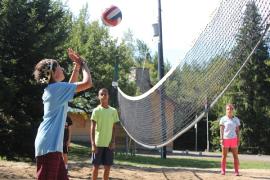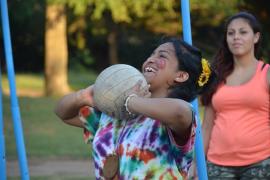This blog is part of a series that gives a snapshot about the results of ACA’s Sites, Facilities, and Programs survey. About 2,426 ACA-accredited camps responded to the survey, and this post features what camps are doing toward environmental stewardship.
If you haven't yet, check out the first part of this research series here: New Camp Industry Research Series, Part 1: Promoting Diversity & Inclusion at Camp
Camps have a long history of valuing outdoor experiences and the environment. Depending on the structure and landscape of the camp, these environmental experiences can look very different. Your camp may be positioned in a natural setting like in the mountains, a dense forest, or on a lake or ocean shoreline. Other camps may be in the heart of a city or in a rural area hosted at a school, library, gymnasium, or public park.
No matter where your camp is located we all have one thing in common: a responsibility to care for the environment and to encourage our campers and staff to be lifelong stewards of the natural world.
So, what did we learn about camps and environment stewardship?
Camps are doing their part to care for the environment through green camp operations and environmental education programs. As children are spending less time in nature and creating fewer connections with natural environments, camps provide a unique opportunity to allow young people to gain a greater appreciation for the natural world, understand concepts related to sustainability, and to experience nature through hands-on activities.
Green Camp Operations
Almost nine out of ten camps have at least one green initiative. The most popular initiative is properly recycling paper, plastic, aluminum and cans, cardboard glass, and motor oil. Some camps have a compost to dispose of food and animal waste. Others have made their facilities green-friendly through low flow toilets and faucets, alternative energy sources (e.g., wind or solar) and energy efficient lighting, heating/cooling systems, and insulation.
Environmental Education Programs
About 85 percent of camps have at least one environmental camp program. Environmental camp programs help campers learn about environmental issues so they can make informed and responsible decisions. Many camps have programs that focus on water and forest ecology, conservation, “Leave No Trace” principles, recycling, wilderness safety, and wildlife viewing.
What else can camps do to promote environmental stewardship?
While the camp industry appears to be implementing green initiatives and engaging campers in environmental education, it is important to assess what else we could be doing. Are there any opportunities to make your camp operations more green? Are you able to expand or add additional environmental education programs?
Easier said than done, right? Doing this costs money and financial barriers can prevent camps from making changes. Grants are a great way to fund these green initiatives. We encourage you to look at a variety of green grants dedicated to this cause and apply for them. Also, check out ACA’s website for a list of grants specific to the camp community. Keep in mind when applying for grants: If at first you don’t succeed, try, try again.
But what can we do to go green right now?
Luckily there’s some easy things you can do at camp right now that cost little to no money. Check out these 6 easy and cheap ways to go green, many of which can be easily applied to camps.
As camp professionals, we are in a unique position to encourage the next generation of nature enthusiasts and environmental stewards. One way we can do this is by making small changes to our camp operations to reduce our impact on the environment, and we need to teach young people to make responsible choices to care for the environment. Findings from the 2017 Site, Facilities, and Programs Survey indicate the camp industry is leading the charge toward sustainability and environmental stewardship, which is great new.
Want to read more? Check out the full report here.
Cait Wilson, MS, is a doctoral candidate at the University of Utah and a research assistant for the American Camp Association (ACA).
Photo courtesy of Sanborn Western Camps, Florissant, CO.
Thanks to our research partner, Redwoods.
Additional thanks goes to our research supporter, Chaco.
The views and opinions expressed by contributors are their own and do not necessarily reflect the views of the American Camp Association or ACA employees.





